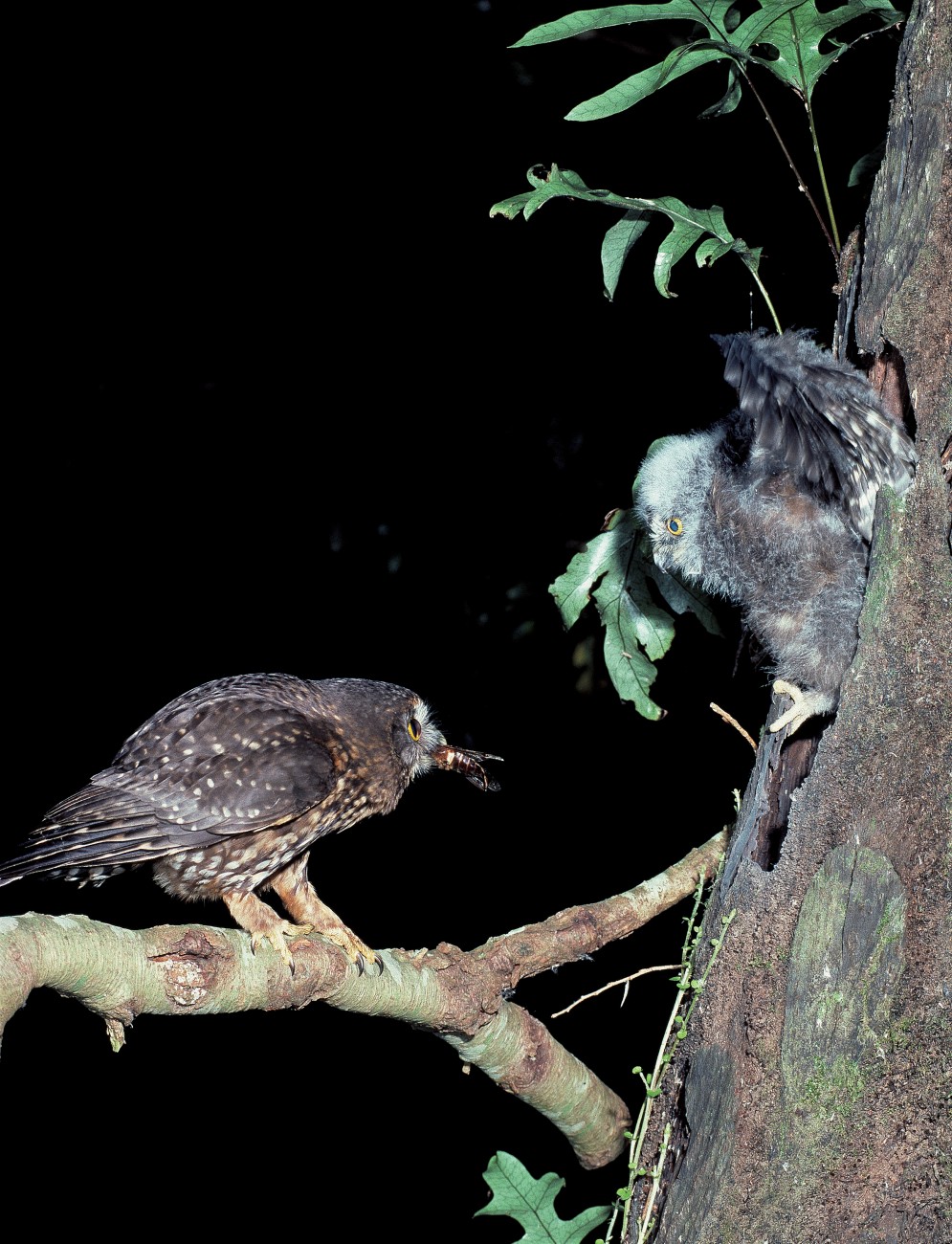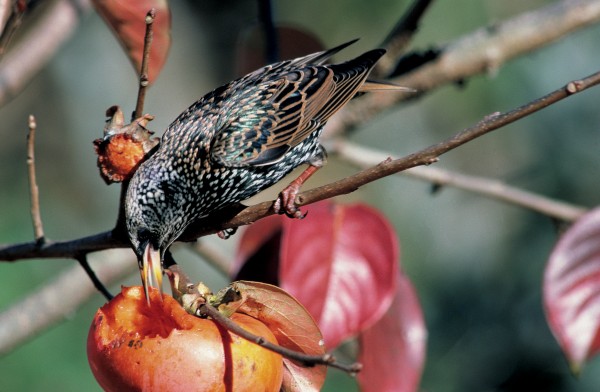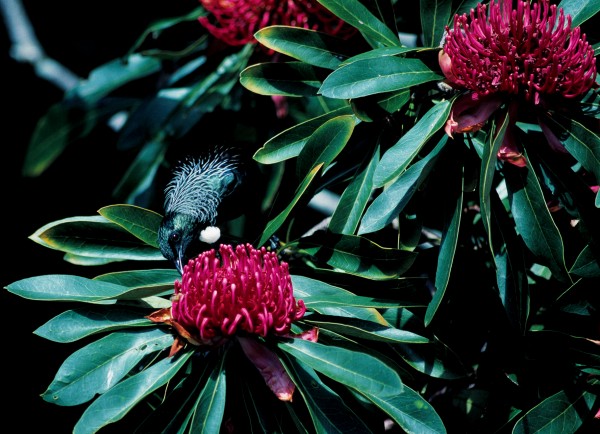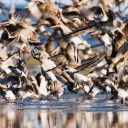
Suburban birds
A trio of welcome swallows preen and primp on a clothesline in the author’s garden. Such small familiar birds are the main form of larger wildlife most city dwellers regularly encounter, and although they are introduced species for the most part, they still enrich our gardens with their mating antics, squabbles over crusts, nest building and songs.


I recall a night a few years ago when a silver-eye started fluttering vigorously against the lighted window of our dining room. For a moment I thought it must have been trying to catch small insects drawn to the outside of the pane by the lights within. But silvereyes aren’t normally active at night, and this bird wasn’t paying any heed to insects. It looked desperate—desperate to get into the house. I went outside and peered around. To my surprise, a few metres back in the gloom loitered a morepork, calmly eyeing the distraught silvereye. I shooed the owl away. It glided noiselessly into the night, and the silvereye scurried off.
There was a time when the morepork, New Zealand falcon and a few other birds of prey were about the only predators native birds had to contend with, but those days have long gone. Gone also are the bush and scrub that once clothed the land, and most native birds have vanished with them.
The new European settlements of the 19th century, with their alien plants and sharp-toothed predators, proved ill-suited to most native birds. Settlers who missed the old country began bringing in birds from their homelands to liven up the countryside around them. They formed acclimatisation societies, the first as early as 1860, to introduce a wide range of animals and birds, some for sport, some as a reminder of “home”, and a few for supposed ecological reasons.
While most of the 130 species of bird brought here failed to establish themselves, 41 have been successful. Some, like the house sparrow, multiplied to plague proportions within just a few years. Indeed, house sparrows became such a pest of crops that children were paid to collect their eggs, and “sparrow clubs” were set up to promote the destruction of house sparrows and other small birds. When these measures proved insufficient, magpies from Australia and little owls from Germany were brought in. While proving effective sparrow hunters, these did little to further the survival of small native birds.

Introduced birds have become the dominant avifauna around our homes, although winter-flowering plants from other lands provide a storehouse of food during the lean season for a few natives such as tui and bellbird. And in the older areas of most towns, where sections are larger and there is an almost forest-like canopy of trees and large shrubs, in‑ sectivores such as the fantail and grey warbler can frequently be seen and heard. It isn’t uncommon for nights to echo to the distinctive cry of the morepork. Around our home in Katikati we have always been able to hear this dumpy little brown owl calling, especially in spring. As recently as early January 2005, a pair fledged three downy young in a hollow in an ancient pine-tree just 100 metres from the house.
Walking the numerous tracks through the neighbouring Kaimai Range can be quite depressing for those with an interest in bird life. If you are lucky you will hear a tui or two, perhaps a fantail, or, if you are especially fortunate, you might catch the distinctive whirr of kereru wings. As in most New Zealand forests, introduced predators have massacred the indigenous bird populations. It takes a visit to a predator-free sanctuary, such as Tiritiri Matangi Island, Little Barrier Island or South-East Island in the Chathams, to get any notion of how New Zealand forests must once have rung with birdsong. Unfortunately these islands are open to only a limited number of people at a time, so few of us have had the privilege of seeing such native rarities as stitchbird, black robin, shore plover and saddleback flying free.
It is a strange fact that bird life is now much more abundant around cities and towns than in most forests. Despite hordes of rats, numerous cats and the odd stoat, many birds not only survive but thrive in residential areas, especially where there is an expanse of fresh water. Large areas of parkland, such as Cornwall Park and Western Springs in central Auckland, provide suitable habitat for quite a few types of bird. Parts of town like Greenlane still have many old houses on large sections with sizeable trees that provide food and shelter for a good number of birds.
[Chapter Break]
The humble house sparrow must be one of the most intelligent and adaptable of birds as well as one of the most common in urban areas. Some have learnt how to trigger automatic door-openers to invade buildings in their search for food. Silvereyes’ beaks are too short to extract nectar from kowhai flowers in the manner of tui, so they peck a hole through the base of the flower to reach it. Sparrows, too, have very short beaks, and it was in 1996, in the grounds of Waihi College, that I first observed sparrows practising the same technique. I have also seen sparrows raiding the seed heads of ripening sunflowers; and they can be an absolute pest in our vegetable garden in summer, shredding the leaves of silver beet.
Apparently bold, house sparrows will take food almost from your hand, but point a camera lens at them and they take off like a shot. Townies provide them with a ready hand-out: stale bread tossed on the lawn is a feast for dozens in many a garden. Their bulky nests can be found in the roofs of older houses, but modern structures provide few openings so they often have to opt for brooding in the dense outer foliage of trees. There they raise four to six chicks at a time, sometimes nesting three or four times from late September to well into January.

The starling is another introduced bird that can be found scrounging even in the middle of the most populated parts of our cities. It’s a hole-nesting bird by nature, and many a garden has a much-used nest box fought over by competing pairs in an environment that provides few other sites suitable for setting up home.
Watching starlings at the nest can be extremely entertaining. The males are extraordinarily good mimics, perfectly reproducing the calls of a multitude of other birds. We had several pairs nesting in boxes on our last property, and it was strange to hear the calls of oystercatchers echoing from the trees outside our workshop, the nearest oystercatcher living as it did in Tauranga Harbour a couple of kilometres away.
Like house sparrows, starlings will visit flowers for nectar, flax flowers being a favourite. Once nesting is over they congregate in flocks, which can be quite large and take a heavy toll on grape crops. I have also seen starlings feeding on persimmons and apples. Winter-roosting flocks of starlings, which typically congregate in favoured trees, can number in the thousands.
Mynas are similar to starlings in their nest-site requirements and can be extremely aggressive at nesting time. If a nest box in which starlings have taken up residence has an entry hole that little bit too large, mynas will take advantage of the fact, quickly asserting their dominance and ejecting the starlings. They are also known to destroy the nests of native birds.


Like many introduced birds mynas are extremely adaptable in a man-made environment. Around Katikati they regularly nest on concrete power poles where stainless-steel sheeting has been wrapped round the upper section to prevent possums climbing up to the lines. Like starlings, they can be quite damaging to fruit crops, and will raid food troughs on pig and poultry farms, but they are never seen in huge winter flocks. Mynas seem to like a warmer climate than most other birds in New Zealand and, despite being widely released in the South Island in the 19th century, are found only in the North Island north of Wanganui and southern Hawke’s Bay.
The blackbird can be an endearing species, almost getting under your feet as you dig in the garden and quickly pouncing on upturned worms and grubs. You will find blackbirds wherever there is an expanse of lawn or open garden and a few dense bushes or trees in which to build their bulky nests. Although these are often within easy reach of domestic cats, the birds win by persistence, nesting first as early as July and then continuing, with nest after nest, right through till late January, each time laying four or five eggs. But like so many introduced birds, the blackbird is a major pest of some crops, especially berry fruits. Some fruits, such as nashi, persimmons and grapes, need to be completely covered in bird-proof netting to keep out these avian gluttons.
Song thrushes are similar to blackbirds in their environmental requirements. Although partial to berry fruits, they are much less of a problem than blackbirds and endear themselves to gardeners with their taste for garden snails. It is common to hear the crack, crack, crack of a thrush bashing a snail shell to pieces on our driveway as it prepares to feast on this pest. They are of an even more residential inclination than the blackbird, frequently nesting in extraordinarily public places. A few years back I photographed a pair nesting in a hanging pot plant right beside the front door of a house, and a week later another pair raising chicks in a nest built on top of an exterior light fitting in a carport a couple of metres from the back door of a house. At the same time, a pair of welcome swallows was raising four chicks in a storage shed off the same carport. Some years earlier, a pair of song thrushes nested a number of times inside a steel-framed shed in a nearby orchard, and during the summer of 2004–05 a pair of thrushes nested in a vine growing in our carport.
It is hard to imagine how welcome swallows survived before human civilisation arose. The species began breeding in New Zealand only in about 1958 but is now abundant almost everywhere except in alpine areas, and I have never seen a nest that wasn’t situated in or on a man-made structure. Welcome swallows are catholic in their choice of nesting site, the only common factor being solid, overhead cover. They frequently favour buildings, where the mess produced by four or five chicks excreting over the side of the nest for a couple of weeks is often more than owners will tolerate, resulting in many a nest being removed.

Where tolerance prevails, the birds prove real entertainers, the chicks ever struggling to be first in line for the endless supply of insects the parents bring as they return to the nest every minute or two from dawn to dark. After fledging, the young often remain around the nest for some days, and if perched on a clothesline can quickly outstay their welcome by splattering drying garments.
Spotted doves were released in some numbers in Mount Eden, in Auckland, in the 1920s and gradually became established throughout the city. They are especially common around Auckland Zoo, where there is an ample food supply in many of the animal enclosures. More recently they have spread south-east, and I first noticed them in rural areas around Tauranga Harbour 10 years ago. The dense hedging around orchards, especially Cryptomeria with its near-horizontal branches, provides ideal nesting conditions. Spotted doves have a long nesting season but lay only two eggs at a time, so their spread has been much less dramatic than that of many other introduced birds. The nest, a mere platform of twigs through which the eggs can frequently be seen from below, needs a solid foundation of strong branches so is more vulnerable to predation by climbing mammals such as rats and cats than are the nests of birds which build in the outer foliage. Spotted doves are gradually moving into Katikati. Shortly before writing this, I heard their distinctive call from quite nearby.
[Chapter Break]
One introduced bird dominates its environment more than just about any other bird I can think of: the mallard. This aggressive interloper has taken over New Zealand’s waterways in a way that is both impressive and depressing. There are now more mallard in New Zealand than all other ducks combined. The drakes are sexually promiscuous and will mate with various introduced domestic breeds as well the native grey duck. Pure grey ducks are now extremely rare around our part of the Bay of Plenty, though occasional birds with faint characteristics of that species can still be spotted. Mallard readily adapt to life on city ponds and lakes, where human hand-outs are plentiful. Come late summer, when water levels fall and temperatures rise, many waters become highly toxic from algal blooms, and where mallard populations are dense the ducks will often succumb to botulism in considerable numbers.
Black swans and Canada geese are two more aquatic birds that have adapted well to city ponds and lakes. These two species eat vast amounts of green plants, which are incompletely broken down in their digestive systems, meaning the birds eject copious amounts of excreta. The lawns at Auckland’s Western Springs are not an ideal place to sit, as black swans, Canada geese and vast numbers of mallard, coots and pukeko spread an ever-fresh coating of fertiliser over the grass every day. But the park is a worthwhile place to visit for anyone interested in birds as it has a great variety of aquatic species. Several years ago a pair of dabchick arrived and bred for the first time; scaup are usually present; and it isn’t uncommon to find a couple of pairs of shags nesting in trees around the pond. Kingfishers were calling from the branches on my most recent visit.
The southern end of Lake Rotorua and Lake Taupo’s Tapuaeharuru Bay bring many seldom-seen birds right into the town environment. Unlike other ducks, scaup aren’t attracted by hand-outs, but they can be seen forming large rafts on both lakes. Dabchick frequently attach their floating nests to jetties and even the inside of boat sheds.


Back in Auckland, Cornwall Park may lack the ponds of Western Springs but has an amazing variety of birds nonetheless. Tui are regulars in late winter, arriving to feed in the flowering cherry trees. Areas of long grass provide ample food for greenfinches and goldfinches, and chaffinches are always present, if inconspicuous, the females being especially plain, resembling as they do female house sparrows.
The least popular bird here would be the Australian white-backed magpie, especially in late winter and early spring, when nesting duties begin. Aggressive males can cause terror in the unwary walker, dive-bombing from behind at great velocity. Their pointed beaks can inflict a nasty wound. Humans are not the only object of their wrath. Other birds intruding on their territory are treated in like manner, and magpies have been recorded killing birds as large as kereru.
I have frequently seen and heard the tiny grey warbler in the trees of Cornwall Park. Eastern rosellas also frequent the area, often feeding on fallen fruit under the Port Jackson and Moreton Bay figs.
Several of the birds that have successfully become established in New Zealand are now rare in their countries of origin. Goldfinches have become scarce in Britain but remain common here. Europe is today home to only a few hundred cirl bunting, whereas there are thought to be at least 10,000 scattered from Northland to Otago (although they are most common in Canterbury and Marlborough).
[Chapter Break]
We can do a lot to attract birds to our gardens. Planting the right trees and shrubs to provide food and shelter can bring more of our native birds to town. Winter‑flowering plants, which provide nectar, are the most effective choice. If sections were large enough, puriri trees would be a good choice for they flower and fruit for six months of the year; but, alas, they require more space than is commonly available.
Introduced Australian and South African plants are smaller draw-cards for birds such as tui, bellbird and kereru. But it is the medium-sized banksias of eastern Australia, such as Banksia collina and B. ericifolia, as well as waratahs, callistemons, kniphofias and large aloes, that add colour to the garden and really bring in the birds. If you have room for a tree you must plant a B. integrifolia, for a well-grown specimen will produce a succession of flowers right through the winter. But I am reluctant to recommend Prunus campanulata, the flowering cherry so much loved by tui, bellbirds and silvereyes. Birds spread the seeds for miles around, where they germinate and invade areas of native forest. The various lillypillies (monkey apples) from Australia are even worse pests and must never be planted.
To protect the birds in and around your garden baiting for rodents is a must. Rats are one of the most destructive predators, raiding nests and often killing sitting adults as well as taking eggs and chicks. They hunt mostly at night so are rarely seen. Baiting needs to be done on a regular basis as rats quickly move into areas cleared of previous murine residents.
The keeping of cats is also to be discouraged. Felines predate millions of birds every year, and a well-fed family pet can be as much a killer as a half-starved stray. Cats hunt for sport as much as for food and frequently leave their kills uneaten. Owners are often ignorant of their cats’ activities, as they roam for much of the day. If you absolutely must keep a cat, keep it indoors and do not allow it free range. It isn’t only birds that suffer: cats kill geckos and skinks, and we have even had neighbourhood cats chasing frogs around our pond!
















